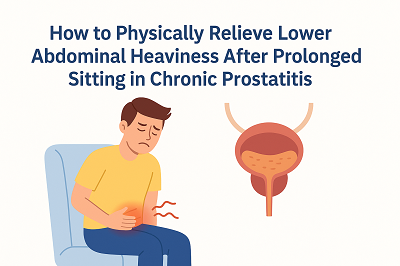How to Physically Relieve Lower Abdominal Heaviness After Prolonged Sitting in Chronic Prostatitis
Chronic prostatitis is a fairly common condition, and one of its most frustrating symptoms is that heavy, dragging feeling in the lower abdomen after sitting for long periods. It's more than just physical discomfort — it can seriously impact your mood and daily quality of life. In this article, let's explore why this symptom occurs and how to relieve it with simple, effective physical techniques.

Why Does Chronic Prostatitis Cause Lower Abdominal Heaviness After Sitting?
1. Prostate Position and Blood Flow Problems
The prostate sits at the bottom of the pelvis, wrapped around the base of the urethra. When you sit for long stretches, pressure on the perineum increases. This can restrict blood circulation in the pelvic area. Since the venous plexus around the prostate lacks proper valves, blood can easily pool or flow backward, leading to congestion and swelling. As pressure builds in the prostate, nearby nerves become irritated — resulting in a sensation of fullness or heaviness in the lower abdomen.
2. Fatigued Pelvic Floor Muscles
The pelvic floor muscles function like a supportive "hammock" for the organs in the pelvis. They're also involved in urination and bowel movements. When you sit still for hours, these muscles remain tense and overworked, losing elasticity over time. Chronic prostatitis can also cause spasms in these muscles, adding further pressure to the prostate, reducing circulation, and disrupting nerve signaling — all of which amplify the feeling of discomfort.
3. Local Heat Triggers Inflammation
Sitting for long periods reduces ventilation in the perineal area, causing heat buildup. In chronic prostatitis patients who already have inflammation, this heat acts like fuel to a fire — increasing the activity of inflammatory factors. This heightened stimulation of surrounding tissues and nerves worsens the sense of heaviness in the abdomen.
Physical Therapy Principles for Relieving Prostatitis-Related Abdominal Discomfort
In simple terms, the discomfort is linked to congestion, poor metabolic waste clearance, and pelvic muscle tension. By using physical methods, we can promote circulation and ease these symptoms naturally.
1. Improve Blood Circulation
Techniques like warm compresses and massage help dilate blood vessels and encourage smooth circulation. As blood flow improves, it clears away inflammatory waste and reduces swelling in the prostate — making the heaviness much more bearable.
2. Relax the Pelvic Floor
Exercises like Kegel movements can help release tight pelvic muscles, restoring flexibility. Once relaxed, these muscles reduce compression on the prostate, allowing better circulation and less pressure.
3. Regulate Nerve Signals
Certain physical therapies help "calm down" overactive nerve signals caused by chronic inflammation. This not only reduces discomfort but also improves sleep and mood, enhancing your body's ability to heal.
4. Temperature Control for Metabolism
Techniques like warm sitz baths help regulate local temperature and reduce inflammatory activity. Better temperature control also boosts metabolism around the prostate, helping the body resolve inflammation more efficiently.
Step-by-Step Methods to Try at Home
1. Warm Compress — Simple and Comforting
Use a hot water bottle or towel soaked in water between 40–50°C. Lie on a bed or sofa and place the compress over the lower abdomen (just above the pubic area). Leave it on for 15–20 minutes, 2–3 times a day. Use a thin cloth to prevent burns if it feels too hot.
Why it works:
The warmth relaxes blood vessels, increases oxygen and nutrient delivery to the prostate, and soothes irritated nerves.
2. Warm Sitz Bath — Relaxing and Therapeutic
Fill a sitz bath basin with 40–42°C water deep enough to cover the perineum. Sit for 15–20 minutes, once or twice a day. Slight movement of the hips during soaking can promote better circulation. Dry the area thoroughly afterward. For unmarried or childless men, reduce frequency and soaking time slightly to avoid any impact on testicular function.
Why it works:
It reduces congestion, flushes inflammatory factors, relaxes tense muscles, and eases discomfort.
3. Kegel Exercises — Strengthen and Relax Pelvic Floor
Identify the pelvic floor muscles by trying to stop urination mid-stream — the muscle used is the one to train. Lie down with knees slightly bent, contract the muscle for 3–5 seconds, then relax for 3–5 seconds. Do 10–15 repetitions per set, 3–4 sets daily. As you progress, extend contraction time and practice standing or sitting as well.
Why it works:
It improves muscle control and flexibility, reduces pressure on the prostate, and boosts circulation.
4. Prostate Massage — Only by Professionals
Performed by a trained medical professional, this involves inserting a lubricated, gloved finger into the rectum to reach the prostate. Gentle massage is done from sides to center to release prostatic fluid. One to two sessions per week are typical.
Why it works:
It helps clear blockages in the prostate ducts, lowers pressure, promotes circulation, and alleviates inflammation and heaviness.
Combine Physical Therapy with Herbal or Medical Treatments
While physical therapies are effective, they may not be enough on their own. Combining them with medications often yields better results:
- Antibiotics: Target bacterial infections.
- NSAIDs (like ibuprofen): Reduce inflammation and pain.
- Alpha-blockers: Relax muscles around the bladder and prostate to improve urination.
For those looking for a natural approach, Diuretic and Anti-inflammatory Pill is a trusted herbal remedy that promotes urination, clears heat and toxins, improves blood flow, and boosts immune function — supporting both symptom relief and long-term recovery.
Note: Always consult a healthcare provider before starting any new treatment plan. Self-medication without diagnosis can worsen your condition.
Daily Habits to Support Prostate Health
- Don't sit for too long: Get up every hour to walk and stretch.
- Stay hydrated & avoid spicy foods: Drink enough water and reduce dietary irritants.
- Regular checkups: Monitor your health and catch problems early.
- Stay positive: Chronic prostatitis takes time to heal, but with consistent treatment and care, you can improve.
Conclusion
That nagging abdominal heaviness after sitting might be frustrating, but it doesn't have to control your life. By understanding the underlying mechanisms and using targeted physical techniques — ideally combined with appropriate medications or herbal therapy — you can reclaim comfort and support your prostate health naturally and effectively.



